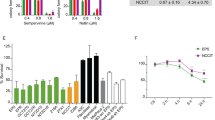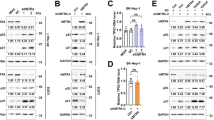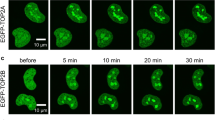Abstract
Nucleolin is a c-Myc-induced gene product with defined roles in ribosomal RNA processing and the inhibition of chromosomal DNA replication following stress. Here we find that changes in nucleolin protein levels in unstressed cells cause parallel changes in the amount of p53 protein. Alterations in p53 levels arise from nucleolin binding to the p53 antagonist Hdm2, resulting in the inhibition of both p53 ubiquitination and Hdm2 auto-ubiquitination. Nucleolin does not alter p53 ubiquitination by human papillomavirus E6, indicating that the effect is specific for Hdm2. Although the inhibition of ligase activity would be expected to stabilize Hdm2, we instead find that nucleolin also reduces Hdm2 protein levels, demonstrating that nucleolin inhibits Hdm2 using multiple mechanisms. Increases in nucleolin levels in unstressed cells led to higher expression of p21cip1/waf1, a reduced rate of cellular proliferation, and an increase in apoptosis. Thus, nucleolin has a number of properties in common with the tumor suppressor ARF (alternate reading frame). We propose that nucleolin, like ARF, responds to hyperproliferative signals by upregulation of p53 through Hdm2 inhibition.
This is a preview of subscription content, access via your institution
Access options
Subscribe to this journal
Receive 50 print issues and online access
$259.00 per year
only $5.18 per issue
Buy this article
- Purchase on SpringerLink
- Instant access to full article PDF
Prices may be subject to local taxes which are calculated during checkout









Similar content being viewed by others
References
Allemand I, Anglo A, Jeantet AY, Cerutti I, May E . (1999). Oncogene 18: 6521–6530.
Anderson CW, Appella E . (2004). In: Dennis Rabaea (ed). Handbook of Cell Signaling, vol 3. Academic Press: New York, pp 237–247.
Bertwistle D, Sugimoto M, Sherr CJ . (2004). Mol Cell Biol 24: 985–996.
Bhat KP, Itahana K, Jin A, Zhang Y . (2004). EMBO J 23: 2402–2412.
Bode AM, Dong Z . (2004). Nat Rev Cancer 4: 793–805.
Borer RA, Lehner CF, Eppenberger HM, Nigg EA . (1989). Cell 56: 379–390.
Borovjagin AV, Gerbi SA . (2004). RNA 10: 942–953.
Bouche G, Caizergues-Ferrer M, Bugler B, Amalric F . (1984). Nucl Acids Res 12: 3025–3035.
Brooks CL, Gu W . (2004). Cell Cycle 3: 895–899.
Bunz F, Dutriaux A, Lengauer C, Waldman T, Zhou S, Brown JP et al. (1998). Science 282: 1497–1501.
Chen D, Kon N, Li M, Zhang W, Qin J, Gu W . (2005). Cell 121: 1071–1083.
Dai MS, Lu H . (2004). J Biol Chem 279: 44475–44482.
Dai MS, Zeng SX, Jin Y, Sun XX, David L, Lu H . (2004). Mol Cell Biol 24: 7654–7668.
Daniely Y, Borowiec JA . (2000). J Cell Biol 149: 799–810.
Daniely Y, Dimitrova DD, Borowiec JA . (2002). Mol Cell Biol 22: 6014–6022.
de Stanchina E, McCurrach ME, Zindy F, Shieh SY, Ferbeyre G, Samuelson AV et al. (1998). Genes Dev 12: 2434–2442.
Donehower LA, Harvey M, Slagle BL, McArthur MJ, Montgomery Jr CA, Butel JS et al. (1992). Nature 356: 215–221.
Dornan D, Wertz I, Shimizu H, Arnott D, Frantz GD, Dowd P et al. (2004). Nature 429: 86–92.
Egyhazi E, Pigon A, Chang JH, Ghaffari SH, Dreesen TD, Wellman SE et al. (1988). Exp Cell Res 178: 264–272.
Freedman DA, Levine AJ . (1998). Mol Cell Biol 18: 7288–7293.
Ginisty H, Amalric F, Bouvet P . (1998). EMBO J 17: 1476–1486.
Ginisty H, Sicard H, Roger B, Bouvet P . (1999). J Cell Sci 112: 761–772.
Godley LA, Kopp JB, Eckhaus M, Paglino JJ, Owens J, Varmus HE . (1996). Genes Dev 10: 836–850.
Greasley PJ, Bonnard C, Amati B . (2000). Nucl Acids Res 28: 446–453.
Gronroos E, Terentiev AA, Punga T, Ericsson J . (2004). Proc Natl Acad Sci USA 101: 12165–12170.
Grossman SR, Deato ME, Brignone C, Chan HM, Kung AL, Tagami H et al. (2003). Science 300: 342–344.
Gulli MP, Girard JP, Zabetakis D, Lapeyre B, Melese T, Caizergues-Ferrer M . (1995). Nucl Acids Res 23: 1912–1918.
Hannan KM, Hannan RD, Rothblum LI . (1998). Front Biosci 3: d376–d398.
Haupt Y, Maya R, Kazaz A, Oren M . (1997). Nature 387: 296–299.
Honda R, Tanaka H, Yasuda H . (1997). FEBS Lett 420: 25–27.
Honda R, Yasuda H . (1999). EMBO J 18: 22–27.
Hsieh JK, Chan FS, O'Connor DJ, Mittnacht S, Zhong S, Lu X . (1999). Mol Cell 3: 181–193.
Itahana K, Bhat KP, Jin A, Itahana Y, Hawke D, Kobayashi R et al. (2003). Mol Cell 12: 1151–1164.
Jin A, Itahana K, O'Keefe K, Zhang Y . (2004). Mol Cell Biol 24: 7669–7680.
Jones SN, Roe AE, Donehower LA, Bradley A . (1995). Nature 378: 206–208.
Kamijo T, Weber JD, Zambetti G, Zindy F, Roussel MF, Sherr CJ . (1998). Proc Natl Acad Sci USA 95: 8292–8297.
Kim K, Dimitrova DD, Carta KM, Saxena A, Daras M, Borowiec JA . (2005). Mol Cell Biol 25: 2463–2474.
Kondo K, Inouye M . (1992). J Biol Chem 267: 16252–16258.
Korgaonkar C, Hagen J, Tompkins V, Frazier AA, Allamargot C, Quelle FW et al. (2005). Mol Cell Biol 25: 1258–1271.
Korgaonkar C, Zhao L, Modestou M, Quelle DE . (2002). Mol Cell Biol 22: 196–206.
Kubbutat MH, Jones SN, Vousden KH . (1997). Nature 387: 299–303.
Kurki S, Peltonen K, Latonen L, Kiviharju TM, Ojala PM, Meek D et al. (2004). Cancer Cell 5: 465–475.
Lee WC, Zabetakis D, Melese T . (1992). Mol Cell Biol 12: 3865–3871.
Leng RP, Lin Y, Ma W, Wu H, Lemmers B, Chung S et al. (2003). Cell 112: 779–791.
Li L, Liao J, Ruland J, Mak TW, Cohen SN . (2001). Proc Natl Acad Sci USA 98: 1619–1624.
Li M, Brooks CL, Kon N, Gu W . (2004). Mol Cell 13: 879–886.
Li M, Chen D, Shiloh A, Luo J, Nikolaev AY, Qin J et al. (2002). Nature 416: 648–653.
Llanos S, Clark PA, Rowe J, Peters G . (2001). Nat Cell Biol 3: 445–452.
Lohrum MA, Ludwig RL, Kubbutat MH, Hanlon M, Vousden KH . (2003). Cancer Cell 3: 577–587.
Lowe SW, Sherr CJ . (2003). Curr Opin Genet Dev 13: 77–83.
Mendrysa SM, McElwee MK, Michalowski J, O'Leary KA, Young KM, Perry ME . (2003). Mol Cell Biol 23: 462–472.
Midgley CA, Desterro JM, Saville MK, Howard S, Sparks A, Hay RT et al. (2000). Oncogene 19: 2312–2323.
Momand J, Jung D, Wilczynski S, Niland J . (1998). Nucl Acids Res 26: 3453–3459.
Momand J, Zambetti GP, Olson DC, George D, Levine AJ . (1992). Cell 69: 1237–1245.
Montes de Oca Luna R, Wagner DS, Lozano G . (1995). Nature 378: 203–206.
Moss T . (2004). Curr Opin Genet Dev 14: 210–217.
Nakamura T, Pichel JG, Williams-Simons L, Westphal H . (1995). Proc Natl Acad Sci USA 92: 6142–6146.
Oliner JD, Pietenpol JA, Thiagalingam S, Gyuris J, Kinzler KW, Vogelstein B . (1993). Nature 362: 857–860.
Olson MO . (2004). Sci STKE 2004: pe10.
Palmero I, Pantoja C, Serrano M . (1998). Nature 395: 125–126.
Park YB, Park MJ, Kimura K, Shimizu K, Lee SH, Yokota J . (2002). Cancer Genet Cytogenet 133: 105–111.
Pomerantz J, Schreiber-Agus N, Liegeois NJ, Silverman A, Alland L, Chin L et al. (1998). Cell 92: 713–723.
Radfar A, Unnikrishnan I, Lee HW, DePinho RA, Rosenberg N . (1998). Proc Natl Acad Sci USA 95: 13194–13199.
Rodriguez MS, Desterro JM, Lain S, Lane DP, Hay RT . (2000). Mol Cell Biol 20: 8458–8467.
Rodriguez MS, Desterro JM, Lain S, Midgley CA, Lane DP, Hay RT . (1999). EMBO J 18: 6455–6461.
Roth J, Dobbelstein M, Freedman DA, Shenk T, Levine AJ . (1998). EMBO J 17: 554–564.
Rubbi CP, Milner J . (2003). EMBO J 22: 6068–6077.
Ruggero D, Pandolfi PP . (2003). Nat Rev Cancer 3: 179–192.
Saez-Vasquez J, Caparros-Ruiz D, Barneche F, Echeverria M . (2004). Mol Cell Biol 24: 7284–7297.
Savkur RS, Olson MO . (1998). Nucl Acids Res 26: 4508–4515.
Sengupta TK, Bandyopadhyay S, Fernandes DJ, Spicer EK . (2004). J Biol Chem 279: 10855–10863.
Sirri V, Roussel P, Gendron MC, Hernandez-Verdun D . (1997). Cytometry 28: 147–156.
Srivastava M, Pollard HB . (1999). FASEB J 13: 1911–1922.
Stommel JM, Wahl GM . (2004). EMBO J 23: 1547–1556.
Stott FJ, Bates S, James MC, McConnell BB, Starborg M, Brookes S et al. (1998). EMBO J 17: 5001–5014.
Sugimoto M, Kuo ML, Roussel MF, Sherr CJ . (2003). Mol Cell 11: 415–424.
Sui G, Affar el B, Shi Y, Brignone C, Wall NR, Yin P et al. (2004). Cell 117: 859–872.
Takagi M, Absalon MJ, McLure KG, Kastan MB . (2005). Cell 123: 49–63.
Tolbert D, Lu X, Yin C, Tantama M, Van Dyke T . (2002). Mol Cell Biol 22: 370–377.
Tyner SD, Venkatachalam S, Choi J, Jones S, Ghebranious N, Igelmann H et al. (2002). Nature 415: 45–53.
Vassin VM, Wold MS, Borowiec JA . (2004). Mol Cell Biol 24: 1930–1943.
Verschuren EW, Klefstrom J, Evan GI, Jones N . (2002). Cancer Cell 2: 229–241.
Wang X, Michael D, de Murcia G, Oren M . (2002). J Biol Chem 277: 15697–15702.
Wang Y, Guan J, Wang H, Leeper D, Iliakis G . (2001). J Biol Chem 276: 20579–20588.
Weber JD, Kuo ML, Bothner B, DiGiammarino EL, Kriwacki RW, Roussel MF et al. (2000). Mol Cell Biol 20: 2517–2528.
Weber JD, Taylor LJ, Roussel MF, Sherr CJ, Bar-Sagi D . (1999). Nat Cell Biol 1: 20–26.
Wsierska-Gadek J, Horky M . (2003). Ann NY Acad Sci 1010: 266–272.
Yang C, Maiguel DA, Carrier F . (2002). Nucl Acids Res 30: 2251–2260.
Zhang Y, Wolf GW, Bhat K, Jin A, Allio T, Burkhart WA et al. (2003). Mol Cell Biol 23: 8902–8912.
Zhang Y, Xiong Y . (1999). Mol Cell 3: 579–591.
Zhang Y, Xiong Y, Yarbrough WG . (1998). Cell 92: 725–734.
Zheng X, Zhang Y, Chen YQ, Castranova V, Shi X, Chen F . (2005). Biochem Biophys Res Commun 329: 95–99.
Zindy F, Eischen CM, Randle DH, Kamijo T, Cleveland JL, Sherr CJ et al. (1998). Genes Dev 12: 2424–2433.
Acknowledgements
We thank Moshe Oren for various constructs and reagents for the cell-free ubiquitination assay, Michele Pagano for the His-Ub vector, Bert Vogelstein for the Hdm2-wt expression plasmid and the HCT116-wt and HCT116-ko cell lines. We also thank A Wilson, P Bhatt and V Vassin for critical comments on the manuscript, and Elena Sokolova for technical assistance. JAB was supported by Philip Morris USA Inc. (15-B0001-42171), the DOD Breast Cancer Research Program (DAMD17-03-1-0299), NIH grant AI29963, and the NYU Cancer Institute and the Rita J and Stanley Kaplan Comprehensive Cancer Center (NCI P30CA16087).
Author information
Authors and Affiliations
Corresponding author
Additional information
Supplementary Information accompanies the paper on the Oncogene website (http://www.nature.com/onc).
Supplementary information
Rights and permissions
About this article
Cite this article
Saxena, A., Rorie, C., Dimitrova, D. et al. Nucleolin inhibits Hdm2 by multiple pathways leading to p53 stabilization. Oncogene 25, 7274–7288 (2006). https://doi.org/10.1038/sj.onc.1209714
Received:
Revised:
Accepted:
Published:
Issue date:
DOI: https://doi.org/10.1038/sj.onc.1209714
Keywords
This article is cited by
-
Ribosomal L1 domain-containing protein 1 coordinates with HDM2 to negatively regulate p53 in human colorectal Cancer cells
Journal of Experimental & Clinical Cancer Research (2021)
-
Nucleolus as an emerging hub in maintenance of genome stability and cancer pathogenesis
Oncogene (2018)
-
MDM2 Degrades Deacetylated Nucleolin Through Ubiquitination to Promote Glioma Stem-Like Cell Enrichment for Chemotherapeutic Resistance
Molecular Neurobiology (2018)
-
The nucleolus, an ally, and an enemy of cancer cells
Histochemistry and Cell Biology (2018)
-
Regulation of the MDM2-p53 pathway by the nucleolar protein CSIG in response to nucleolar stress
Scientific Reports (2016)



